I'm no expert but I believe that it's about creating a carbon environment (wood shavings, leaf litter, etc) which will neutralize the nitrogen in the droppings to create a neutral environment and help surpress the ammonia which can be so harmful to the lungs of our chickens.
Navigation
Install the app
How to install the app on iOS
Follow along with the video below to see how to install our site as a web app on your home screen.
Note: This feature may not be available in some browsers.
More options
You are using an out of date browser. It may not display this or other websites correctly.
You should upgrade or use an alternative browser.
You should upgrade or use an alternative browser.
Is hay okay to use on the floor of your chicken house in the winter?
- Thread starter wvchickenhouse
- Start date
I'm trying to figure out which type of wood chipper will produce the kind of flakes I buy at TSC for $5 per bale. Does anyone know?
Hay will work just fine. It's all I've used in all my years of raising chickens (except when it gets hard to find once in a while, and then I just go in the woods with the wheelbarrow and get a mess of pine needles until I can get some more hay). I spread it so it's about 6 inches thick (once it's walked on by the chickens, it's closer to about 3 inches but still 'springy') and every 3 or 4 days I go out and turn it with a rake. After maybe 2 weeks +/-, I put it in a wheelbarrow and spread it on areas that washout easily or need mulching and fertilizer to get some grass growing (If I can remember, I'll take pictures to show just what two years of this starts to do for the yard. It adds a layer of topsoil and grass starts to grow where only rocks seemed to grow well. It stops washout and fills in the washed valleys better than straw because it 'piles' better, instead of drying out into light straw again and blowing away or washing away...hard to explain what I mean by that, but anyway...). The hay spread in the yard brings more bugs and the chickens love to scratch around in it which helps break it down more and more into a nice top-soil eventually and feeds the chickens somewhat. Hay just smells better, period, even when it's time to take it out of the coop and spread it, it's still smells better than dirty straw...and looks better spread out in the yard too! Yes, I've tried straw, but it did not impress me enough to keep using it when I had my own hay fields and 100 acres of woods I could get leaves and pine needles from. I don't have the hay fields anymore (we had to move unfortunately), but still have enough woods that I'll not need to worry about having enough pine needles if I need to substitute for hay any amount of time.
Don't let anyone tell you you *shouldn't* until you get at least a reference of plenty of experience or cites to why something shouldn't be used, other than 'that's what I've heard' type of thing. I give my 25 years of experience for the above reasoning of why I use hay. Take it or leave it but it's true, not just 'hearsay'.
----------
Here's a bunch of pictures I said I'd try to take. One would have to be blind and dumb to not see the difference where hay has been spread compared to where the straw has been spread. (the picture with the red circling and the blue circling: red = straw area blue = hay area)
In the pictures where I'm trying to show where hay is now allowing grass to grow, that hay was spread out there for the past 5 months, and grass is growing nicely.
The picture(s) where straw is...that straw has been there for the past 4 and a half years(!) and it's done nothing but slow a little of the washing out of the hillside and failed miserably at a lot of that. Barely, if any, grass is growing where it's been spread and lain for all those years.
The pictures are all labeled so that when you hover the pointer or open them up it should tell what it is (I hope).
Another reason I don't care for shavings (of any type) is that they don't break down any better than straw, unless one has one of the newer type's of compoters that makes it easy to turn and can make compost in a couple of months instead of a couple of years. If one has one (or two!) of those though, I'd *never* use straw or shavings again, since my hay would compost even faster than it does now *without* a composter, open on the ground in 5 months...I would bet a month, maybe 6 weeks and I'd have compost. Those two to four earlier weeks means I can make *more*, more often. It's a win-win no matter how you look at it. Thing is, not many can afford those nice composters (I sure wish I could though!).
My outlook on the deep litter method (and this is just my opinion, like it or not I'm allowed to have one!) - it's lazy! It's no different than you putting a clean sheet over a dirty one each time you would normally pull the dirty one off to wash it. After 15 sheets are nice and dirty, you *still* have one heck of a job to clean all those dirty, stinking sheets when it's time to get them all off. If I, disabled as I am and in pain 24/7/365 (my pain pills just barely take the sharp edge off the pain) and walk bent over for the rest of my life, can go out every 3 to 4 days (or when I smell it needs it) to turn the hay in the coop for the birds, anyone should be able to (including my 11 year old nephew who *does* do it when he visits, believe it or not, without complaining!). Straw and shavings are okay in a pinch, but the best and only other use for them is as mulch, since not much grows where it's dumped or takes so long to grow you could have sowed seed and gotten better results in 3 months.
As I said in my original post, hay works beautifully in a coop. If it's 'getting slimy' or whatever, you're not using enough for the amount of birds in the coop or simply not turning it as often as it needs. Straw gets just as nasty when it's wet...what, anyone thinks straw can magically make wet and wet-smell disappear? It has to stay just like it does on hay, but IMO hay doesn't smell as bad as straw when it's wet chicken poop in it. I'm not trying to *make* anyone use hay over straw or shavings, etc., I'm just trying to get the point across that straw *sin't* all it's cut out to be and that if hay is used, and used correctly, and a little more effort (re work) is put into it, the benefits of hay over straw/shavings/etc outweigh everything else. I guess that's all I can say about it. The naysayers and those who haven't used hay much and are going mostly by something they've only read or heard will argue I suppose. I'll just post this and hope experience means something to someone out there.
Not too happy with straw...
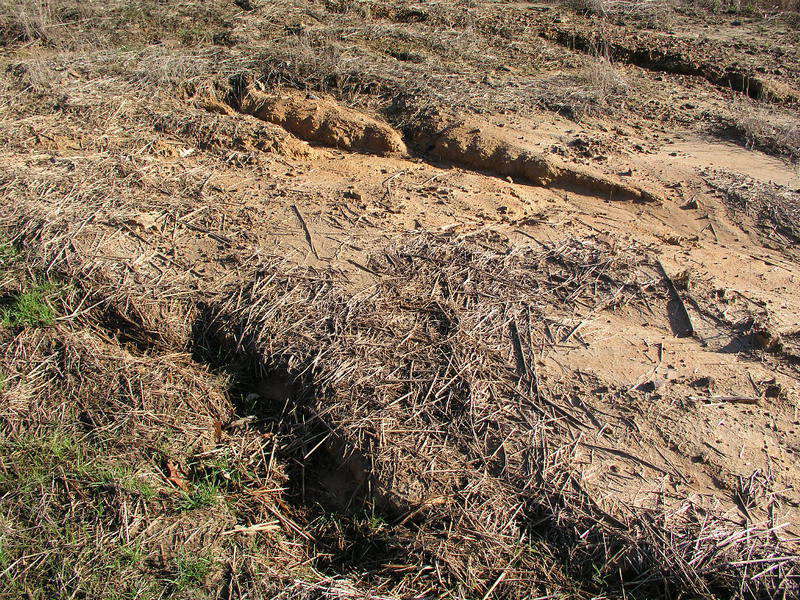
This is barely more than plain sand, and what I'm using the *hay* to help turn into a halfway decent soil...
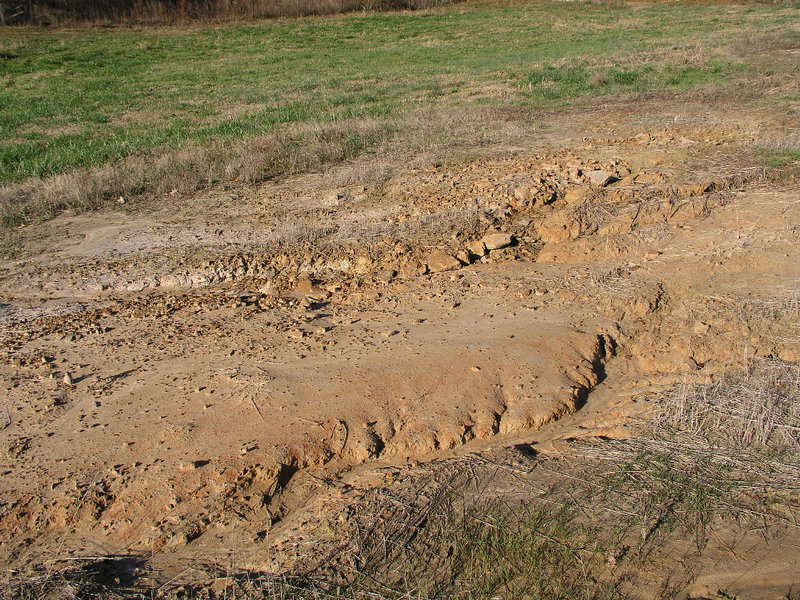
Here below, you see that in 4 and a half years straw hasn't helped stop erosion much nor has it composted or broken down into the dirt nor helped anything grow (BTW, I sowed grass seed under the straw hoping for the best because we'd just moved here. It was slightly past hay season and I couldn't find hay for sale anywhere nearby at the time. None of the seed took, I presume because of the poorness of the soil).
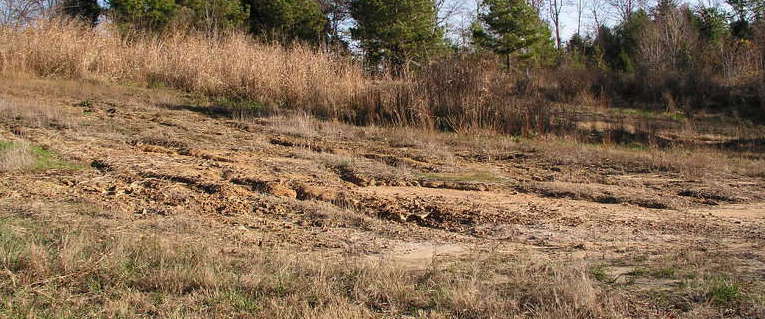
The real bad bare/no-growth areas are the straw, everything else is from only 5 months of putting hay out from the chicken coop, which means it all wasn't spread at one time, but over a period of 5 months at ~2 week intervals. You can come and take my straw if you want it, it's useless.
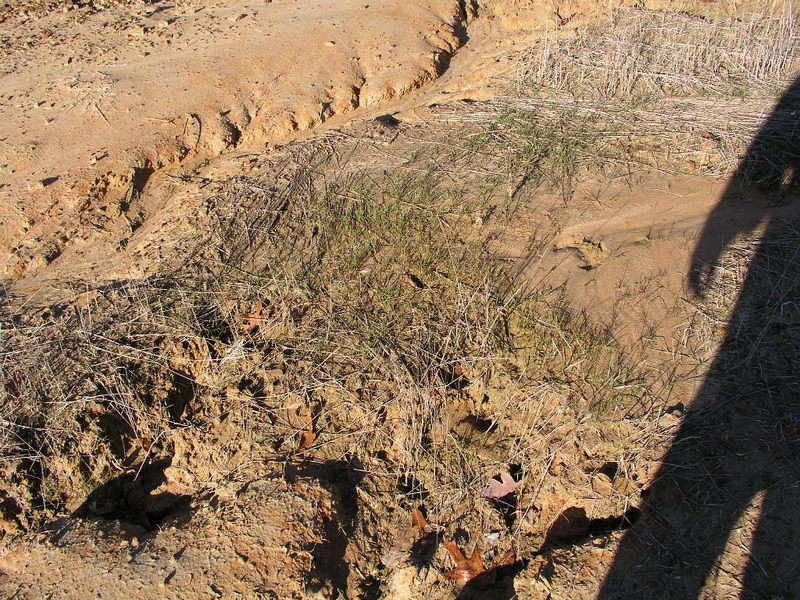
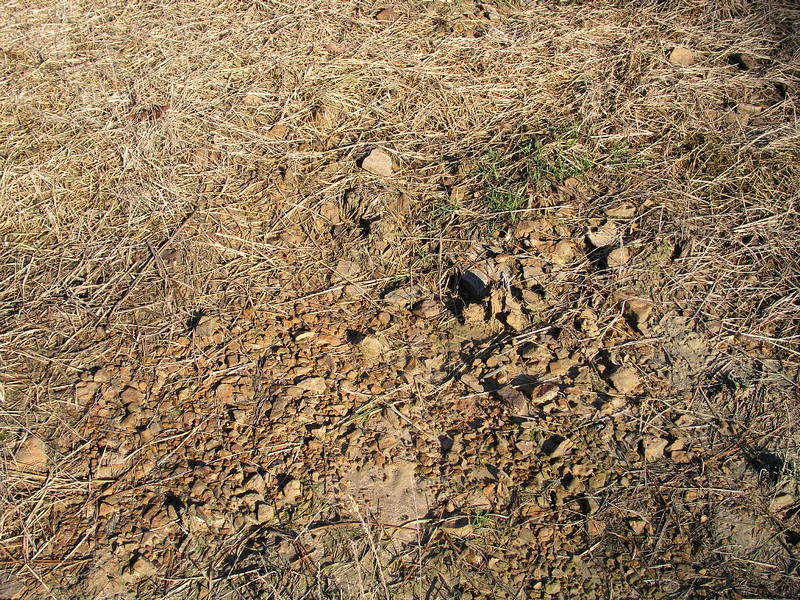
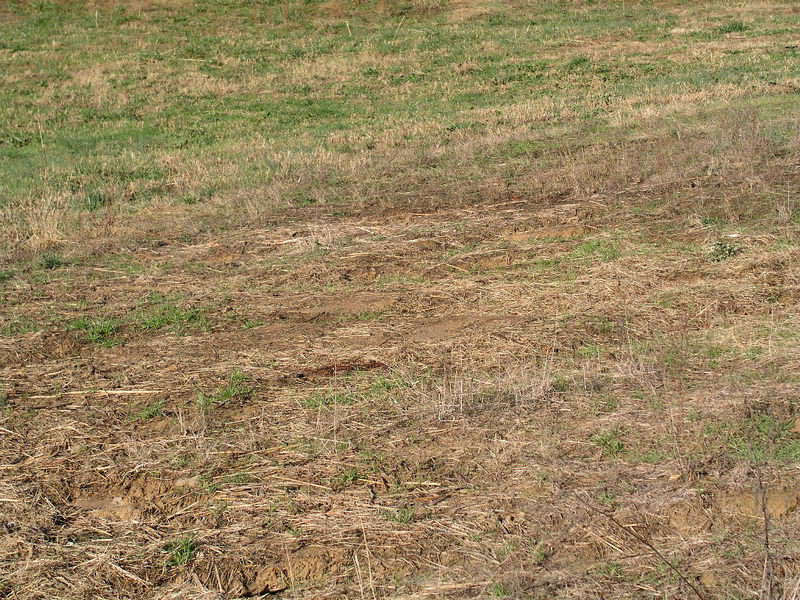
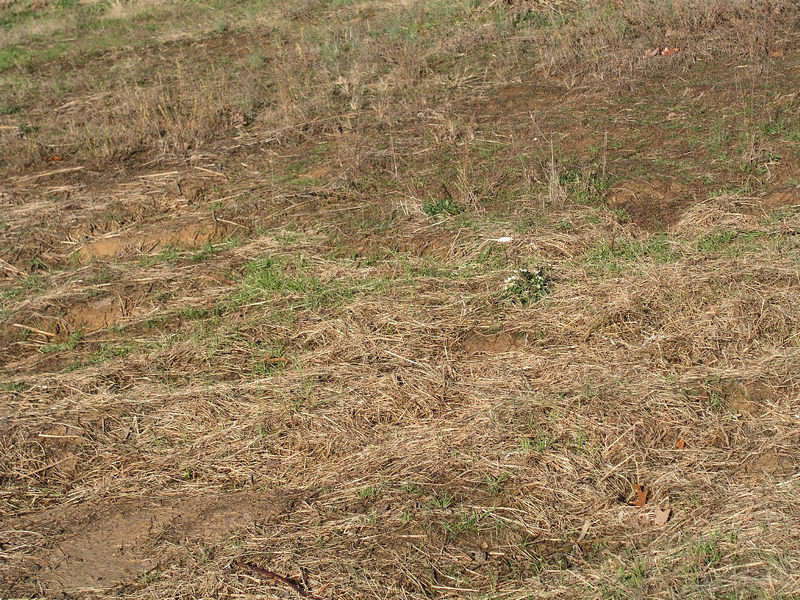
Areas of grass popping up still even after three hard frosts...all in the hay areas.
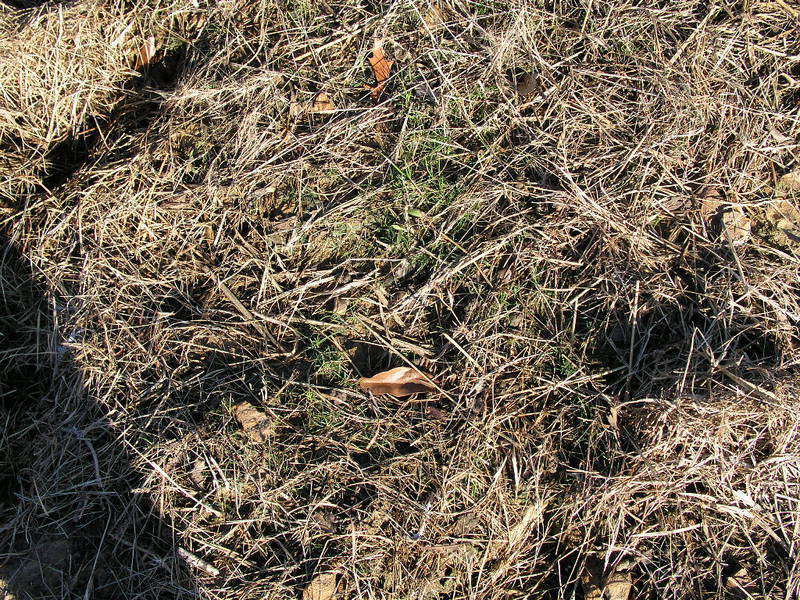
Inside the red circled area is where straw (and grass seed) has been for 4 and a half years. Inside the blue circled area is where I've been spreading the hay from the coop for only the past 5 months.
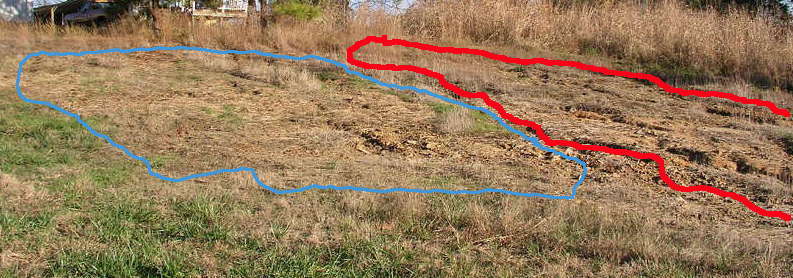
Don't let anyone tell you you *shouldn't* until you get at least a reference of plenty of experience or cites to why something shouldn't be used, other than 'that's what I've heard' type of thing. I give my 25 years of experience for the above reasoning of why I use hay. Take it or leave it but it's true, not just 'hearsay'.
----------
Here's a bunch of pictures I said I'd try to take. One would have to be blind and dumb to not see the difference where hay has been spread compared to where the straw has been spread. (the picture with the red circling and the blue circling: red = straw area blue = hay area)
In the pictures where I'm trying to show where hay is now allowing grass to grow, that hay was spread out there for the past 5 months, and grass is growing nicely.
The picture(s) where straw is...that straw has been there for the past 4 and a half years(!) and it's done nothing but slow a little of the washing out of the hillside and failed miserably at a lot of that. Barely, if any, grass is growing where it's been spread and lain for all those years.
The pictures are all labeled so that when you hover the pointer or open them up it should tell what it is (I hope).
Another reason I don't care for shavings (of any type) is that they don't break down any better than straw, unless one has one of the newer type's of compoters that makes it easy to turn and can make compost in a couple of months instead of a couple of years. If one has one (or two!) of those though, I'd *never* use straw or shavings again, since my hay would compost even faster than it does now *without* a composter, open on the ground in 5 months...I would bet a month, maybe 6 weeks and I'd have compost. Those two to four earlier weeks means I can make *more*, more often. It's a win-win no matter how you look at it. Thing is, not many can afford those nice composters (I sure wish I could though!).
My outlook on the deep litter method (and this is just my opinion, like it or not I'm allowed to have one!) - it's lazy! It's no different than you putting a clean sheet over a dirty one each time you would normally pull the dirty one off to wash it. After 15 sheets are nice and dirty, you *still* have one heck of a job to clean all those dirty, stinking sheets when it's time to get them all off. If I, disabled as I am and in pain 24/7/365 (my pain pills just barely take the sharp edge off the pain) and walk bent over for the rest of my life, can go out every 3 to 4 days (or when I smell it needs it) to turn the hay in the coop for the birds, anyone should be able to (including my 11 year old nephew who *does* do it when he visits, believe it or not, without complaining!). Straw and shavings are okay in a pinch, but the best and only other use for them is as mulch, since not much grows where it's dumped or takes so long to grow you could have sowed seed and gotten better results in 3 months.
As I said in my original post, hay works beautifully in a coop. If it's 'getting slimy' or whatever, you're not using enough for the amount of birds in the coop or simply not turning it as often as it needs. Straw gets just as nasty when it's wet...what, anyone thinks straw can magically make wet and wet-smell disappear? It has to stay just like it does on hay, but IMO hay doesn't smell as bad as straw when it's wet chicken poop in it. I'm not trying to *make* anyone use hay over straw or shavings, etc., I'm just trying to get the point across that straw *sin't* all it's cut out to be and that if hay is used, and used correctly, and a little more effort (re work) is put into it, the benefits of hay over straw/shavings/etc outweigh everything else. I guess that's all I can say about it. The naysayers and those who haven't used hay much and are going mostly by something they've only read or heard will argue I suppose. I'll just post this and hope experience means something to someone out there.
Not too happy with straw...

This is barely more than plain sand, and what I'm using the *hay* to help turn into a halfway decent soil...

Here below, you see that in 4 and a half years straw hasn't helped stop erosion much nor has it composted or broken down into the dirt nor helped anything grow (BTW, I sowed grass seed under the straw hoping for the best because we'd just moved here. It was slightly past hay season and I couldn't find hay for sale anywhere nearby at the time. None of the seed took, I presume because of the poorness of the soil).

The real bad bare/no-growth areas are the straw, everything else is from only 5 months of putting hay out from the chicken coop, which means it all wasn't spread at one time, but over a period of 5 months at ~2 week intervals. You can come and take my straw if you want it, it's useless.




Areas of grass popping up still even after three hard frosts...all in the hay areas.

Inside the red circled area is where straw (and grass seed) has been for 4 and a half years. Inside the blue circled area is where I've been spreading the hay from the coop for only the past 5 months.

Last edited:
Quote:
Not likely, I'm afraid, that you can produce your own in the volume you'd need.
Shavings for bedding come from planes, not chippers. Makes them something of a green alternative, but also an economic imperative for lumber mills. Just producing lumber produces three kinds of waste in the mill -- edgings, sawdust and shavings. Edgings with the bark still on them are most often chipped though they can be handled to separate the bark for processing and sale as mulch. Chips, in any event, often go to biomass boilers for energy production. A great deal of sawdust, anymore, goes into pellets for woodstoves. The shavings are the spill of the planers that produce finished lumber.
They're planer shavings, not chips. Not to snipe at your question. It's a good one. But I can't imagine, short of owning a lumber mill, how I might produce enough shavings to keep my birds dry and happy.
Not likely, I'm afraid, that you can produce your own in the volume you'd need.
Shavings for bedding come from planes, not chippers. Makes them something of a green alternative, but also an economic imperative for lumber mills. Just producing lumber produces three kinds of waste in the mill -- edgings, sawdust and shavings. Edgings with the bark still on them are most often chipped though they can be handled to separate the bark for processing and sale as mulch. Chips, in any event, often go to biomass boilers for energy production. A great deal of sawdust, anymore, goes into pellets for woodstoves. The shavings are the spill of the planers that produce finished lumber.
They're planer shavings, not chips. Not to snipe at your question. It's a good one. But I can't imagine, short of owning a lumber mill, how I might produce enough shavings to keep my birds dry and happy.
New posts New threads Active threads
-
Latest posts
-
Shadrach's Ex Battery and Rescued chickens thread.
- Latest: no fly zone
-
-
-
-
-
-
Latest threads
-
-
Bee sting or bug bite, swollen face
- Started by Fluster Cluck Acres
- Replies: 0
-
-
Open Contest Official BYC Caption Contest 05-17-24 Pic by HopKat
- Started by BYC Project Manager
- Replies: 5
-
-
-
Threads with more replies in the last 15 days
-
Open Contest May Madness, a Random Funny Posting Contest
- Started by casportpony
- Replies: 2K
-
What’s the deal with you chicken people??
- Started by z3lda3
- Replies: 805
-
-
Things I don't feed my chickens😊
- Started by ilovemybabychickies
- Replies: 134
-
-
